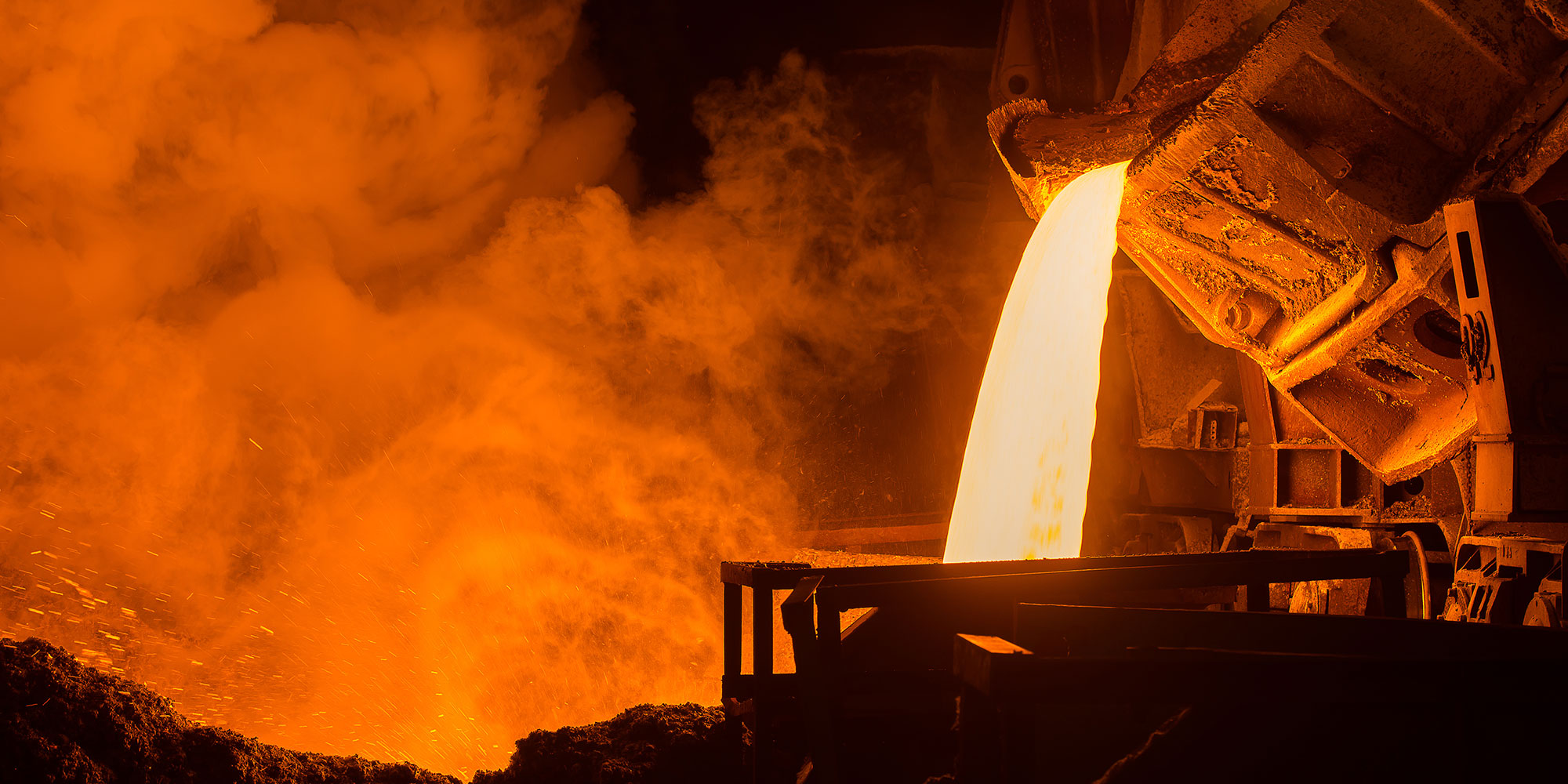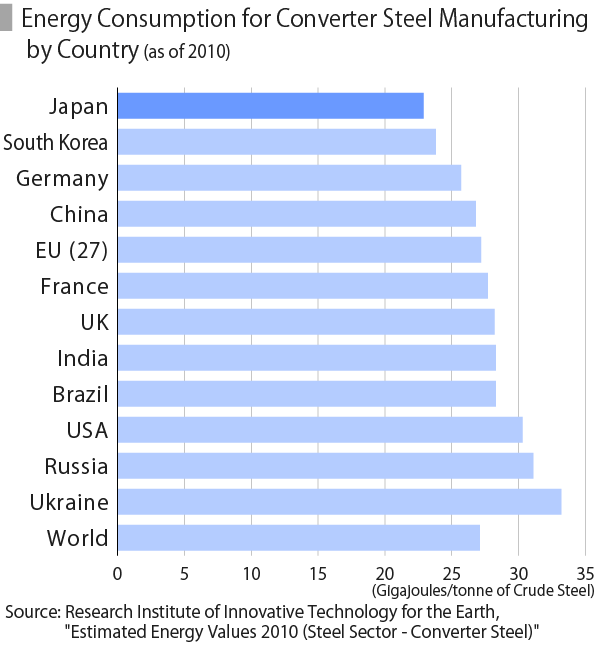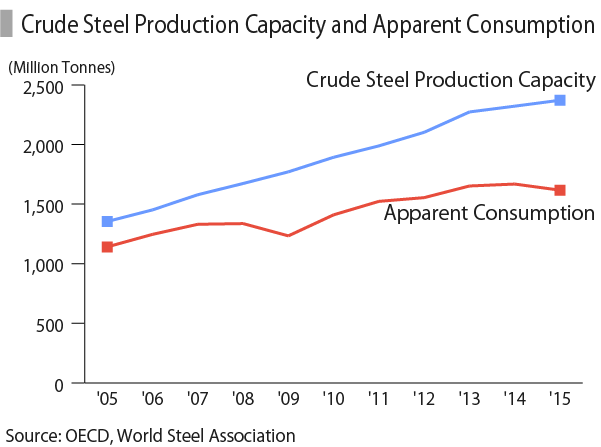A Brief Glance at Japan’s Blast Furnace Steel-Related Industries
|
The following is the third instalment in a special edition SPEEDA series. Industries related to blast furnace steel are the focus of this report, and the information is based on the value chain provided in SPEEDA, as well as the fluctuations of fundamental figures disclosed in the securities reports of companies across a ten-year period. |
|
Steel Is a Key Industry for Japan Steel has a broad range of applications from infrastructure to areas in daily life. Steel products find use in residential buildings, roads, bridges, automobiles, shipbuilding, home appliances, and industrial machinery. In addition to being a backbone industry, steel manufacturing plays a particularly important role. In 2014, it accounted for 7.6% (JPY 6.9 trillion) of the GDP for all manufacturing industries in Japan combined. Japan has been maintaining the second spot in crude steel production globally, right after China, which has been showing remarkable growth in recent years. 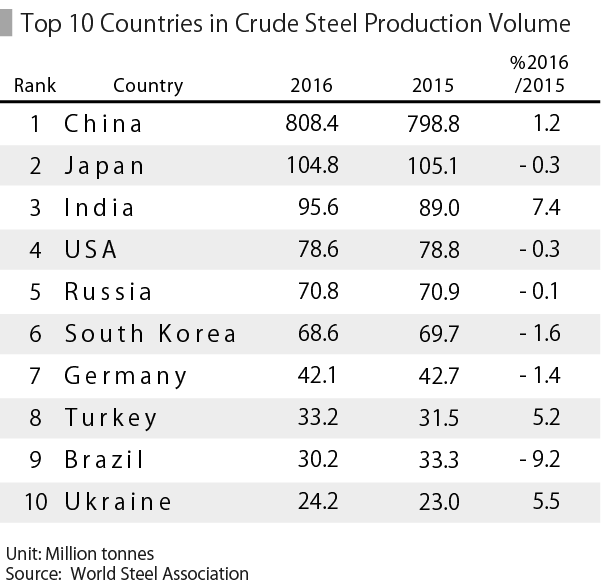 |
|
2015 Production Volumes for Japanese Crude Steel Manufacturers A look at the production volumes of crude steel in 2015 shows that ArcelorMittal holds an overwhelming lead in the steel industry. Nippon Steel & Sumitomo Metal and JFE Steel (subsidiary of JFE Holdings) also make the ranks, standing in third and eighth place, respectively. In October 2016, fifth place Baosteel Group and eleventh place Wuhan Iron and Steel (Group) Corp. integrated, with the resulting combined crude steel production volume moving up to second place. 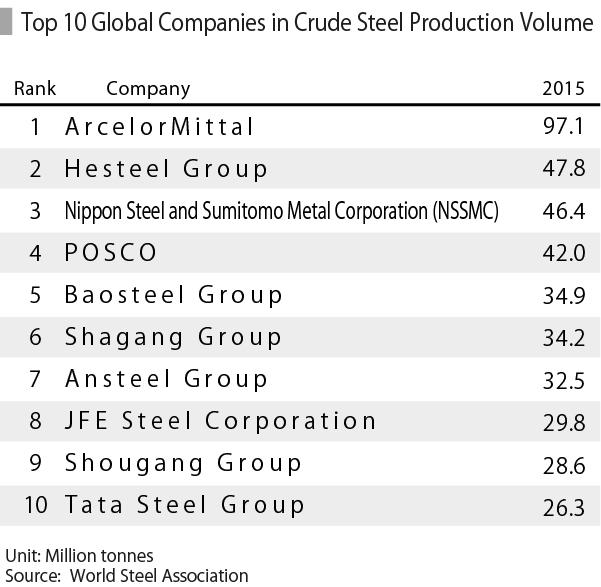 |
|
Companies in the Value Chain Below is the value chain for the blast furnace steel industry. Both high-quality and regular steel are manufactured via blast furnaces, though regular steel is also manufactured via electric furnaces. Furthermore, there are electric furnaces for the manufacturing of special steel and ferroalloy. 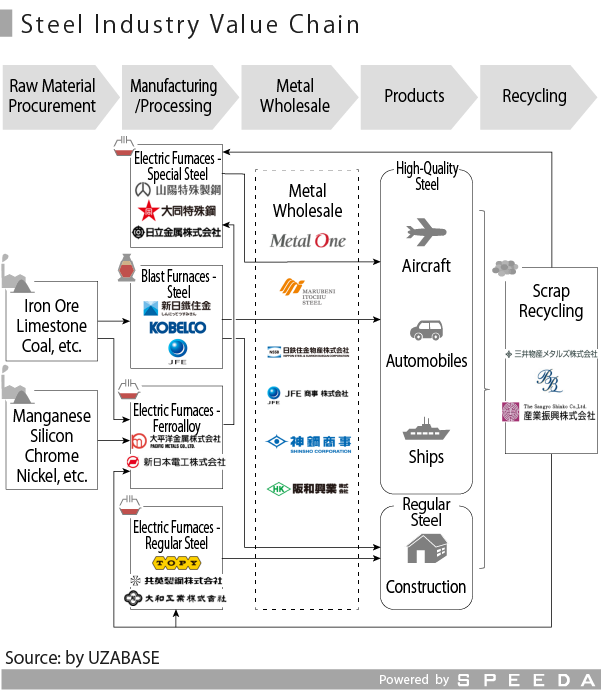 |
|
Industry Trends: Steel Is a Key Export Item for Japan Exports have been on the rise in recent years for such products as steel plates for use at Japanese automobile manufacturers’ assembly plants. The export value of steel was JPY 4.5 trillion in 2008, fell temporarily to JPY 2.9 trillion in 2009, but recovered thereafter, rising to JPY 3.5 trillion and then JPY 4.0 trillion. However, it fell again in 2016, dropping to JPY 2.8 trillion. Nevertheless, coupled with the stagnation in electronic component exports, the share of steel in the value of exports overall rose to 4.1% (JPY 2.8 trillion) in 2016 from 3.1% (JPY 1.6 trillion) in 2000. Furthermore, exports account for 40% of the total crude steel production volume. 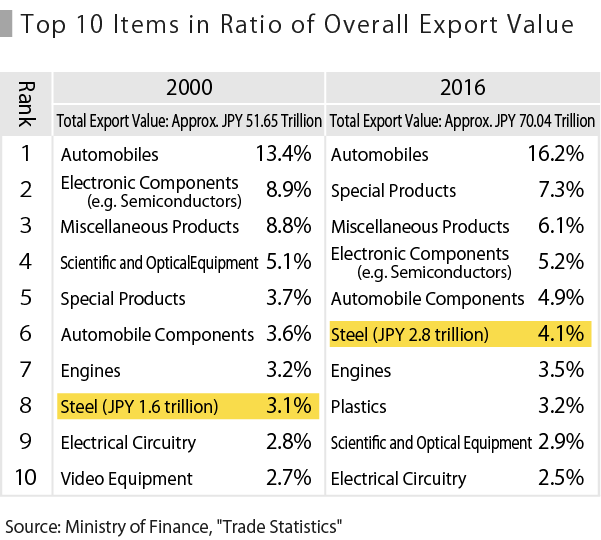 |
|
Realising the Highest Energy Efficiency in the World Converter steel, which is manufactured via blast furnaces, is the mainstream across the world. The differences between the technological levels of countries are relatively large when it comes to the development of converter steel, and this type of steel is the most important factor for international energy efficiency comparisons. Furthermore, such a comparison was carried out in 2010, and was the first of its kind in the world. Below are estimated figures for the energy consumption of converter steel manufacturing by country as of 2010. A low amount of energy consumption implies high energy efficiency, and Japan currently ranks top globally in energy efficiency for converter steel. Japan’s top place is likely attributable to the use of energy-efficient technologies and energy management for all steel plants. With that being said, the manufacturing of steel via blast furnaces is burdened with environmental issues, as it results in massive electrical power consumption and carbon dioxide emissions. In order to tackle these issues, technological developments have been underway in recent years, such as the improvement of manufacturing methods in order to reduce carbon dioxide emissions. |
|
New Steel Manufacturing Method “ITmk3” Garnering Attention as Countermeasure to Environmental Issues A new steel manufacturing method known as “ITmk3”, which was developed by Kobe Steel, has been receiving attention as a countermeasure to environmental issues. ITmk3 is a process wherein high-purity granular iron for electric furnace steel is produced from low-grade iron ore and low-grade coal, which cannot be used in the blast furnace process. With ITmk3, it is possible to produce high-grade pig iron (96–97% iron content) equivalent to that produced via a blast furnace. Furthermore, this process takes a mere ten minutes to manufacture what a blast furnace takes eight hours to smelt. In addition, the process also has the merit of about a 20% reduction in carbon dioxide emissions through a substantial cut in the amount of energy used. Commercial production with ITmk3 has already begun in the USA, with projections that production will increase in future. |
|
Desire for High-Quality Steel Manufacturing with Electric Furnaces Blast furnace steel processes often garner attention since they can manufacture both high-quality and regular steel. However, in the area of electric furnaces for regular steel, Ricoh announced in March 2012 that it will employ the use of electric furnace steel plates, developed jointly with Tokyo Steel Manufacturing, in the structural components of its all-in-one copiers. In April 2013, Japan’s Ministry of the Environment succeeded in the trial manufacturing of high tensile strength steel plates used in construction through electric furnaces, and was able to produce steel plates that are equivalent in quality to those produced via blast furnaces. Currently, the manufacturing of steel plates for automobiles is said to have the most difficult technological requirements amongst steel production technologies. However, there has been an increasing desire to use electric furnaces for the manufacturing of high-quality steel in this area. |
|
Companies Consolidating Production Bases to Strengthen Price Competitiveness In order to strengthen their price competitiveness, blast furnace manufacturers have been consolidating their production bases, and then strengthening the facilities at those bases. 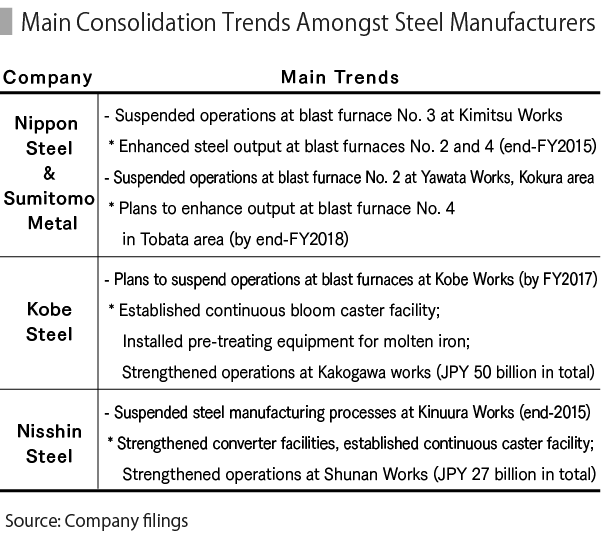 |
|
Competition Amongst Materials Predicted to Take Full Force Aluminium and carbon fibres have come to replace steel materials used in such areas as railway vehicles and aircraft. Going forward, such competition between materials is also expected to take full force for automobiles, one of the primary areas of demand for steel materials, in order to meet weight reduction requirements. |
|
Reorganisations Continue in Japan’s Steel Industry Amongst blast furnace companies, domestic steel leader Nippon Steel and third place Sumitomo Metal underwent an absorption-type merger in October 2012, establishing Nippon Steel & Sumitomo Metal, which then became number two globally in crude steel production volume after ArcerolMittal. In that same month, Nisshin Steel and Nippon Metal Industry underwent management integration. More recently, Nippon Steel & Sumitomo Metal announced its agreement with Nisshin Steel to turn the latter into a subsidiary by March 2017, thus consolidating Japan’s blast furnace manufacturers into three companies: Nippon Steel & Sumitomo Metal, JFE Steel, and Kobe Steel. In electric furnaces for regular steel, on the other hand, there are around 40 SMEs. As such, in June 2015, Japan’s Ministry of Economy, Trade and Industry (METI) announced that it would promote business reorganisation in the field, through such activities as the consolidation of production facilities and integration between companies. However, amidst a contracting market due to a decline in the construction of new homes and investment in public infrastructure, electric furnace companies are currently in a state of structural oversupply. While pushing for overseas expansion, METI will also hold an investigation based on Article 50 of the Act on Strengthening Industrial Competitiveness and proceed with reorganisation if the oversupply does not improve over the next two to three years. With this flow of events, Osaka Steel turned Tokyo Kohtetsu into a subsidiary via a public tender offer in March 2016. |
|
Global Steel Market Conditions In order to confirm the global market conditions for steel, it is important to first take a look at the crude steel production volumes by major region. In 2005, China’s production volume exceeded that of Europe, and rose to the top thereafter. Other regions, however, are showing a flattening trend to marginal decline. 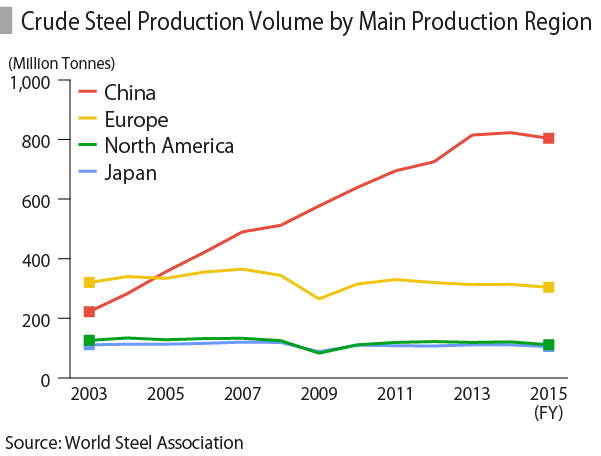 Even with the rise in production volume, is it balanced with supply and demand By 2005, the gap between crude steel production capacity and the apparent consumption of steel was approximately 210 million tonnes. However, by 2015, that gap more than tripled to about 750 million tonnes.
Furthermore, a look at the price trends for iron ore, a raw material for blast furnaces, shows that the price rose gradually from USD 28.11 per tonne in 2005 to USD 187.18 per tonne by February 2011. The price of iron ore had recently declined, but has been back on an uptrend since 2016. Similarly, the price of coking coal rose sharply from 2008 to 2009, and relaxed thereafter. However, the price has not yet returned to the level it was at before 2003. Such price increases for raw materials (iron ore and coking coal) put pressure on the operating profits of steel manufacturers. 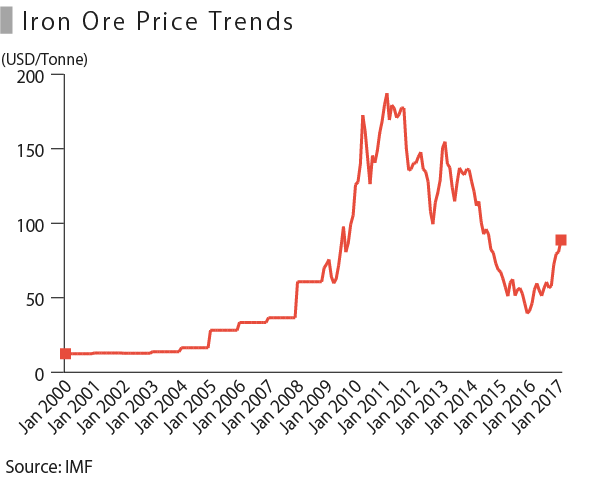 |
|
Ten Years Ago and Now: A Comparison of Figures for Leading Companies The following compares trends for leading industry players over FY2005–15. See below for trends in revenues, operating profits, and operating profit margins. These trends show that operating profits are declining overall. Steel-related industries witnessed substantially more rapid growth than other fields in FY2005, owing to increased demand from China, but then experienced a remarkable decline due to negative effects from the global financial crisis. There was no recovery thereafter, which is thought to be a result of worsening conditions in the global steel market and price rises for raw materials caused by increased production capacity in China and South Korea. In terms of revenue, Nippon Steel & Sumitomo Metal and Hitachi Metals saw increases in their revenues due to management integrations. JFE Holdings, Kobe Steel, and Yamato Kogyo also reported substantial revenue increases. |
|
Market Capitalisation and EPS Fluctuation  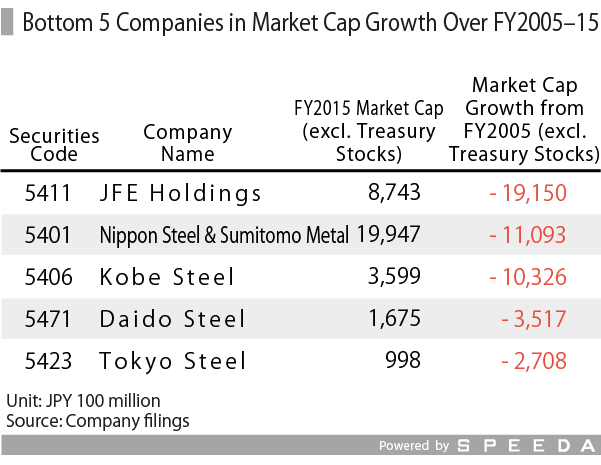 Above is a list of companies based on the amount of growth in their market capitalisations (excluding treasury stocks) in FY2015. There were only two companies that experienced an increase over FY2005–15. Nippon Steel & Sumitomo Metal is ranked top in market capitalisation in the industry. 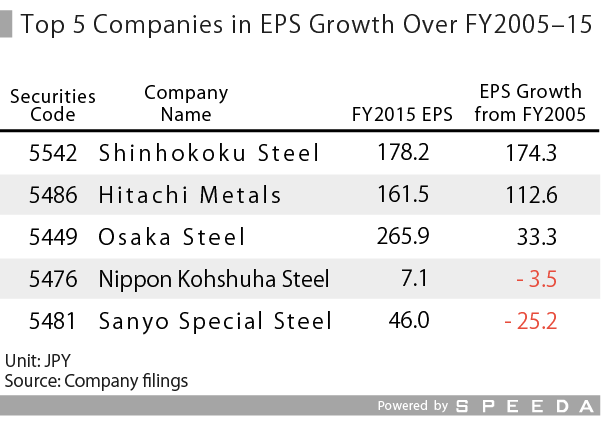 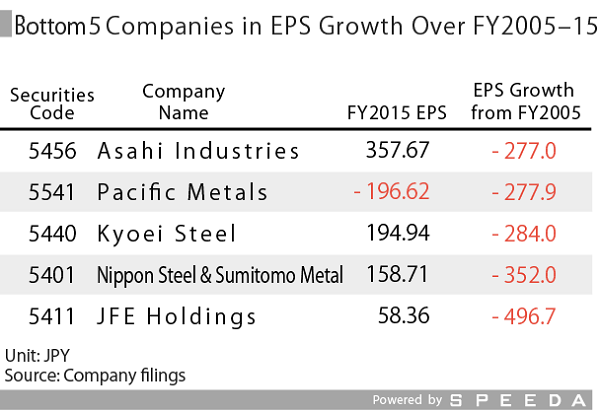 |
|
Capital Investment 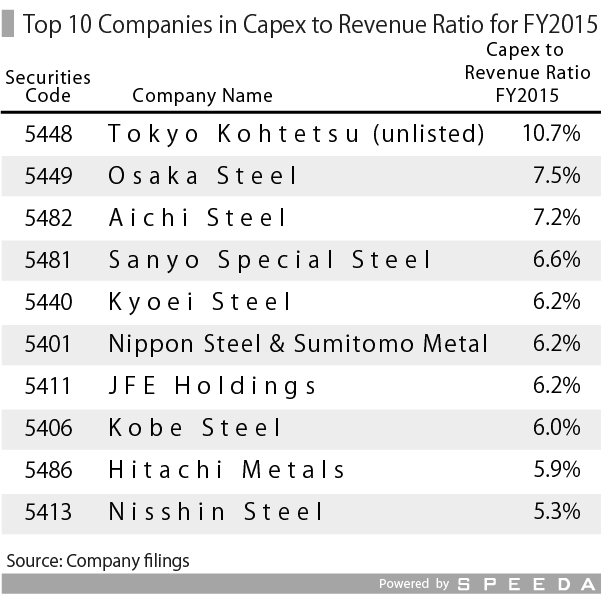 A look at the ratio of capital investment (capex) to revenue for FY2015 shows that this industry has a high percentage of capital investment compared to other industries, given that it handles industrial processes. |
|
Employees in the Blast Furnace Steel Industry 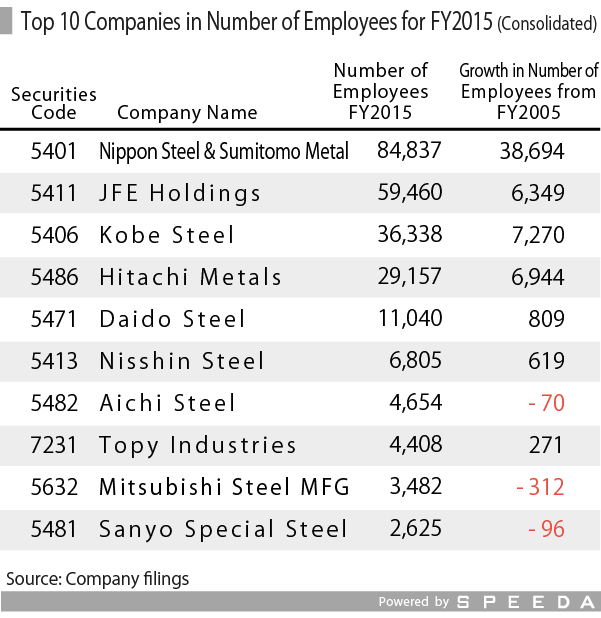 In terms of employee number for the entire group, Nippon Steel & Sumitomo Metal is at the top with about 85,000 employees. Furthermore, the margins of increase for both Nippon Steel & Sumitomo Metal and Hitachi Metals are high due to their management integrations. JFE Holdings and Kobe Steel have also been increasing their number of employees through M&A activities. Few companies have decreased their employee numbers substantially despite worsening operating profits. 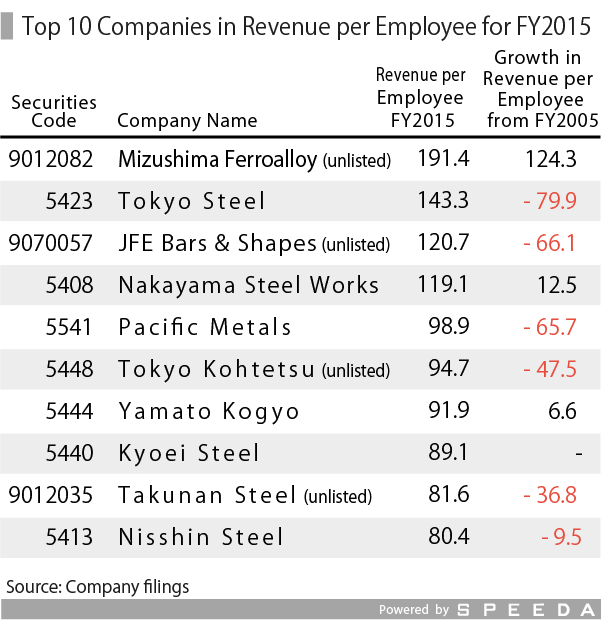 A look at the amount of revenue per employee reveals that electric furnace companies rise above blast furnace companies. In particular, although the number of employees is decreasing for Mizushima Ferroalloy, the company’s revenue is on the rise, and is at a high level compared to FY2005. Tokyo Steel was at the top in FY2005 with over JPY 220 million. However, there have not been any changes in the company’s number of employees, yet its revenue is declining tremendously, pushing the company down to second in FY2015.  Note: Average salary and average age are on a non-consolidated basis.
When looking at the average employee salary for each company, blast furnace companies like JFE Holdings and Nippon Steel & Sumitomo Metal, and special steel electric furnace companies like Hitachi Metals, Aichi Steel, Daido Steel, and Sanyo Special Steel all make the top ranks. |
|
In Closing: Potential in Superior Technology With an oversupply in China, conditions in the steel industry are worsening, and companies are taking on domestic consolidation and overseas expansion as their primary strategies. However, Japanese companies possess a high level of technological ability in such areas as weight reduction and high tensile strength. For automobile components in particular, they have superior technologies in high tensile strength steel plates and special steel. In its medium-term management plan, Nippon Steel & Sumitomo Metal plans to increase R&D expenses by 10%, suggesting that the extent to which companies can enhance their superiority in technological ability will be the topic moving forward. |
